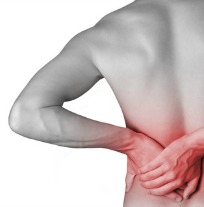Golf Related Back Injuries
Back injuries are the most common injuries in golf, when you look at incidence rates of both amateurs and professionals combined! The repetitive nature of golf has a tendency to increase the amount of stress placed through your back, especially if muscles or other tissues aren't working in an efficient manner. This lack of efficiency could be attributed to tight muscles, weak muscles, pre-existing conditions, age, and posture to name a few. Injury prevention is one of the main reasons why a golf weight training program heavy with core exercises and stability training is so important!
Maintaining flexibility and strength throughout this area via core exercises is essential! This becomes even more important as we age because our body naturally loses some of its flexibility and increased stress will be placed through these structures.
Also, you need to make sure that your body is in proper alignment during your stance. Proper posture puts your spine in a more efficient position and will allow for smoother, and greater, rotation.
Your posture can be affected by any number of factors, but muscle imbalance is something that can be found in most people. This is mostly due to environmental factors such as our jobs, or lifestyles. Those who sit for the majority of their day can easily develop tight hip flexors and weak mid back muscles, for example. Any sort of imbalance will cause your tissues and structures to respond differently to stress, and will increase the likelihood of a golf injury.
The area of the low back that is the most susceptible to injury in golf is the disc space of L5-S1. In general terms, that is the space between your last vertebrae in your back and your tailbone. This specific location is commonly injured because a larger amount of rotation occurs here in comparison to the other lumbar vertebrae.
My intention for this page is only to provide information regarding common injuries to the low back. This is not to be used as a substitute for consultation from a physician or other healthcare provider. The following conditions are in no particular order.

1.Degenerative disc disease (DDD) - As the name implies, this is degeneration of the discs that sit between each of the vertebrae in your spine. As we age, our discs lose their water content and become less flexible as well as smaller in size. DDD is a chronic issue that gradually develops over time. DDD is one of the reasons why we get shorter as we age! These back injuries can also lead to stenosis and/or compression of nerve roots.
2. Disc Herniation - Commonly referred to as a disc bulge. This is where the outer layer of your disc gives way, and it allows to inner portions to force their way either into a bulge, or full herniation. A bulge (or protrusion) is where the outer layer is still intact compared to a herniation where the outer layer actually tears and allows the inner content to leak out. A disc bulge/herniation is a serious issue because the majority of disc bulges are posterior or posterior-lateral in nature. What lies directly posterior to your discs is your spinal cord as well as the nerve roots that exit from either side of the spinal cord. While not all disc bulges are symptomatic, more severe cases with pinch the nerve roots and cause pain down the pathway of that nerve (Remember, the nerves from your neck travel down your arms, and the nerves from your low back travel down your legs).
3. Spondylosis - More commonly referred to as arthritis. In your spine, this can occur in the facet joints. The facet joints connect each vertebrae to the one above it and below it. Spondylosis can cause pain and stiffness with movement. Sometimes, these facet joints can become "stuck", either in a open (back forward bent) or closed (back extended) position. This can be extremely painful. Performing flexibility exercises prior to your round will help reduce some of this stiffness.
4. Muscle Strain - Quick stretch/pull of the low back musculature. Likely to occur in a forceful swing. This type of back injury most likely will resolve itself within a few days but could take up to a few weeks in severe cases. You will most likely have difficulty with bending forward and/or rotating to either side. Rest, activity modification, and light flexibility exercises are ways to help alleviate this type of pain.
As I mentioned above, back injuries are extremely common. If your pain is severe, traveling down an extremity, accompanied by numbness/tingling, or doesn't go away within a few days, please consult your physician!
The best way to combat these back injuries, both as prevention and treatment, is through a golf weight training program that focuses on flexibility and core exercises.
Home Page > Golf Injuries > Back Injuries





New! Comments
Have your say about what you just read! Leave me a comment in the box below.